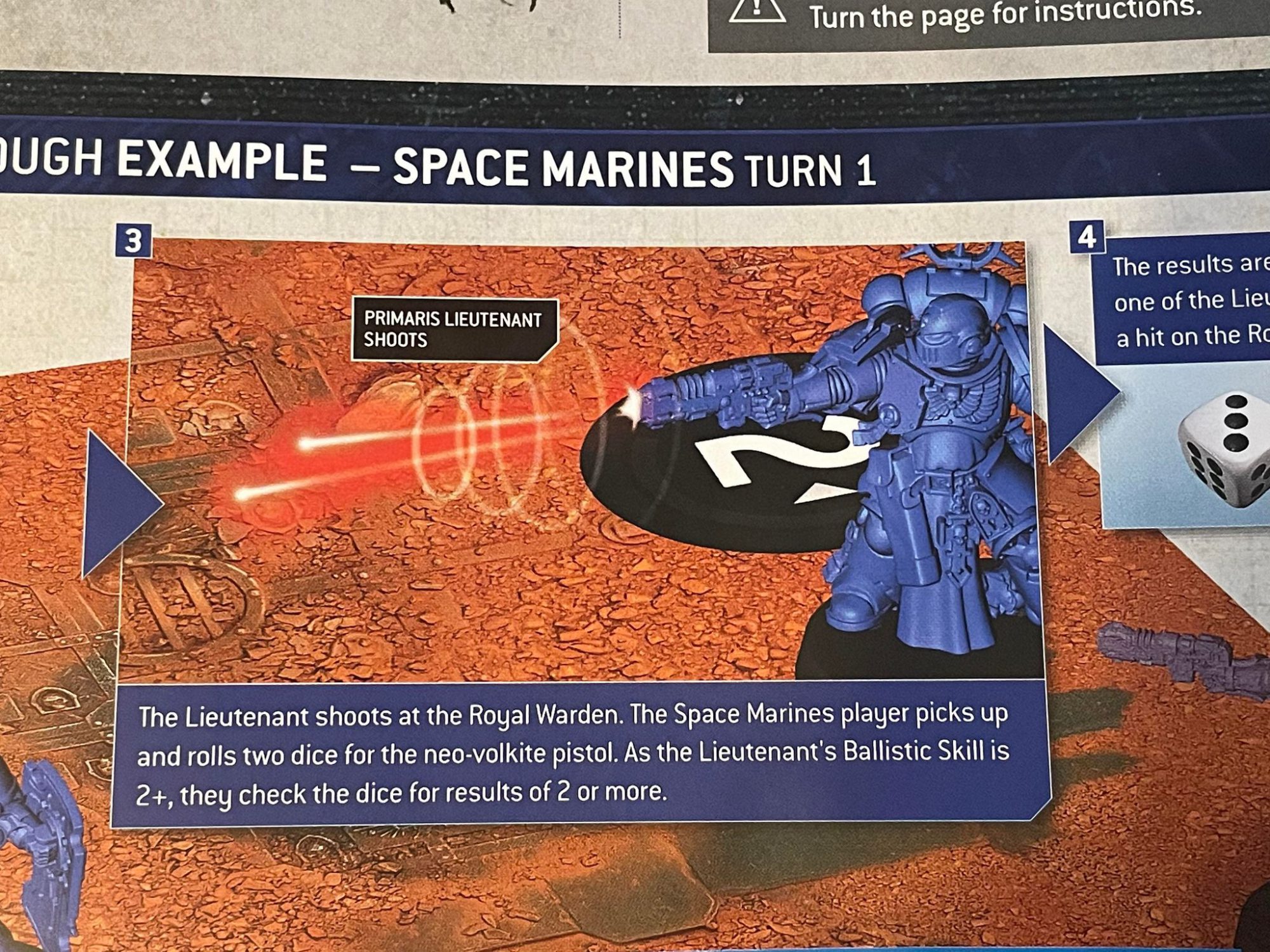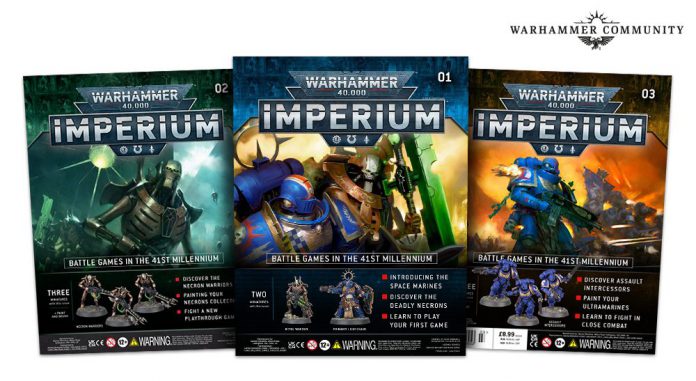Imperium is a weekly hobby magazine from Hachette Partworks. In this 80-week series, our intrepid magazine-receiver will be reviewing each individual issue, its included models, and gaming materials. A Premium subscription was provided to Goonhammer for review purposes.
This is the second part of an ongoing series. If you missed part 1 (week 0) of the series, you can find it here.
I recently was waiting in line at the post office, preparing to mail off a post-holiday gift to a friend of mine. A mouthy, unmasked yahoo in a Let’s Go Brandon t-shirt was giving the postal clerk a hard time, perceiving her matter of fact statements about shipping delays as personal slights. She said, folksily, “It’s a miracle anything gets delivered at all right now”. With this in mind, I should not have been surprised when my first delivery of Imperium encountered a shipping delay.
In the interest of transparency, I was expecting to have this first article out in January, not the listless February doldrums I currently find myself in. For subscribers, one does not get individually packaged issues week-by-week, but a package containing a few weeks’ worth of issues plus any bonus material. In my case, a baggie was yeeted into my door by the UPS guy. Said baggie contained issues 1-3, so there’s my next three weeks covered.
The Magazine
Each issue of Imperium comes with a veritable ream of printed materials, detailed on an In This Issue manifest. These are included largely as loose papers with a pair of holes punched in them. In time, these will be fitted into your Warhammer-branded Trapper Keeper, a later Imperium gift. Maybe this is my inner ugly American showing, but I am not aware of binders available in my home country for mere two-hole punched papers, so these will be paperclipped together for the time being.
The writing, layout, and design of these materials are on par with any issue of White Dwarf. A fold-out insert details The War for Ramasus, where one side has a bevvy of open-ended proper nouns to stir the imagination. It lays out who the Ultramarines and Szarekhan forces are along with some lovely art straight out of their respective codices. The reverse side has a lovely spread of the newer models for both factions with little boxouts explaining the various roles these different heroes, troops, and war machines will have on the battlefield. It’s pretty standard starter set stuff, and the kind of thing that stirred the imagination of my younger self.

You get a double-sided page each for the Lieutenant and Warden, detailing their equipment, heraldry, some light lore, and in-universe quotes from grumpy dudes in the corner. Most importantly, you get multiple bespoke name generators for the character, their title/epithet, and names for their equipment. You can also write your own Purity Seals, so with a little rolling I have:
Lieutenant Caestus Ignus, Bane of the Fivefold, armed with Traitor’s End and Purity, covering himself safely behind his shield, Grim Defiance. His Purity Seal bears the prayer “Rub a dub dub, thanks for the grub” and his Record of Battle says he defeated Trakhsis, The Gleeful Eradicator, on the world of Derek’s Mom’s Dining Table IV
I swear this is not a bit; I love this stuff. It shows how much you can personalize Your Dudes and gives a solid framework to start from. This is followed up with a pair of general lore/art pages for the Space Marines and Necrons and some in-depth building tutorials. These tutorials go further in depth than the tiny card inserts you get in a character blister, with written as well as 3d rendered instructions. There are even arrows showing where on the sprue one should clip. It has the advice to lay out all the bits ahead of time, which I frankly find to be somewhat problematic, especially as a one size fits all approach to model assembly. I do not trust myself not to lose a just-round-enough-to-roll Space Marine head if I leave it on my desk whilst plugging away at the other parts of the model. I also wish it advised hobbyists to clean mold lines, as aside from just being an aesthetic preference, it can affect how models fit together at times. A rudimentary paint guide follows this up, largely just defining what the various paints are – painting is for a later issue.
The section on playing 40k contains a sentence that reads as a self-actualization and self-own simultaneously:
“Warhammer 40,000 uses a set of rules that are easy to learn and interesting to master.”
Maybe this is my New England WASP upbringing shining through, but “interesting” is something I often read as a veiled insult, in the way my mom would say my extremely loud Pushead-designed Metallica shirt was “interesting” instead of “badass” or “hard as hell”. My personal anecdotes notwithstanding, this section lays out what turn-based wargames are and lets you know that in the coming issues, more missions and tutorials will be coming to expand your play experience. This particular issue’s play experience will be fleshed out further down the page.
Last but certainly not least, there is a free poster. On one side, an ad for all the other stuff you’ll get in Imperium and its premium expansion. On the other side, a lovely piece of art showing Space Marines and Necrons duking it out. I will hang it in my garage.
The Models

Included in the first issue is a Space Marine Primaris Lieutenant and a Necron Royal Warden. Both of these models will be familiar to anyone who has sampled Indomitus or any varietal of modern 40k starter sets. Their details are crisp, their designs appealing, and they go together with only a smidge of effort and plastic glue. Both are representative of their respective factions, and serve as solid, mid-level characters that will find their way into many eventual armies. The Lieutenant can also easily be folded into a Bladeguard Veterans squad if you wanted to bulk out their number a bit.
The Gaming Materials
On the tactile side of things, this comes with rather cute clear ruler and six dice. I may not be Kevin “Hammer of Math” Genson, but if my math is correct (and it is) the dice each have six sides and the ruler is precisely 12 inches. It’s pretty clear this is aimed at first time hobbyists, which, contrary to the “Best Newcomer 2019” Armies on Parade award I have, I am not.
A double-sided 11″x15″ card playmat is included, with a little Martian desert with 5 marked alphabetical spots on one side and a Necron laser tag arena on the other. The sidebar has wound counters and objective markers to be cut out. It’s nice to have a little arts and crafts project, as a treat.

Players are introduced to the First Contact mission, in which the Necron player is defending their awakening tomb complex and the Space Marine player is trying to blow it up. The scenario is played on the Martian side, with the laser tag arena to be used at a later date. The alphabetical spots are used to label where the Marine and Necron deploy, as well as three objective markers, representing the Necron repair nodes. The Necron player goes first, as their Royal Warden only has 4 wounds compared to the 5 of the Marine Lieutenant.
The rules are written in a pretty clear A. B. C. sort of order, with detailed photos showing how everything should go. Concepts like measuring are clearly defined, so you know to measure front to front with bases and the like. There are also cute little photoshopped images of the models shooting lasers at each other, which hopefully made some graphic designer’s day:

The combat here is simplified, skipping the wound step entirely. The Necron fires 2 shots looking for 3+, which the Marine saves on 3+. The Marine fires 2 shots at 2+, which the Necron also saves on 3+. After both players have their first turn, the Necron player can try and activate a repair node on a 5+, in which case they win. The Marine player wins if they kill the Necron Royal Warden. The wrinkle here is that if the Warden fails to activate a repair node, it is removed. From what I can tell it’s possible to kill the Lieutenant and fail to activate all three nodes, driving home both the “nobody ever really wins” aspect of 40k, and the SRM special where I table my opponent and still manage to lose the game. Chilling stuff.
For your very first 40k tabletop experience ever, this is dead simple and shouldn’t take more than 5-10 minutes. It lets a player get a grasp on physically moving models, rolling dice, saving, allocating wounds, and playing for objectives. It couldn’t be more lightweight, and for a younger player it seems like the exact sort of thing you would want for their very first exposure to the game. There are two easily defined sides with two easily defined objectives, and taking turns playing the two is easy to do. I do wish there was some incentive for the Marine player to actually move their model though. There is no melee or counter-objective play here, so the Lieutenant may as well be a gun turret for this very basic introductory scenario. I guess that would make it easier if you were coaching a first timer through or trying to learn on your own.
Final Verdict 1/80:
The quality of everything in Imperium is pretty dang good. We have highly detailed models straight out of the starter set, White Dwarf-caliber graphic design and print layout, an introduction to the Warhammer hobby, and some bonus gaming goodies. The included scenario is borderline too simple for an adult, but for a wee one should give them a first taste of what 40k can all be about.
See you next issue, Warhams.
Have any questions or feedback? Drop us a note in the comments below or email us at contact@goonhammer.com.


